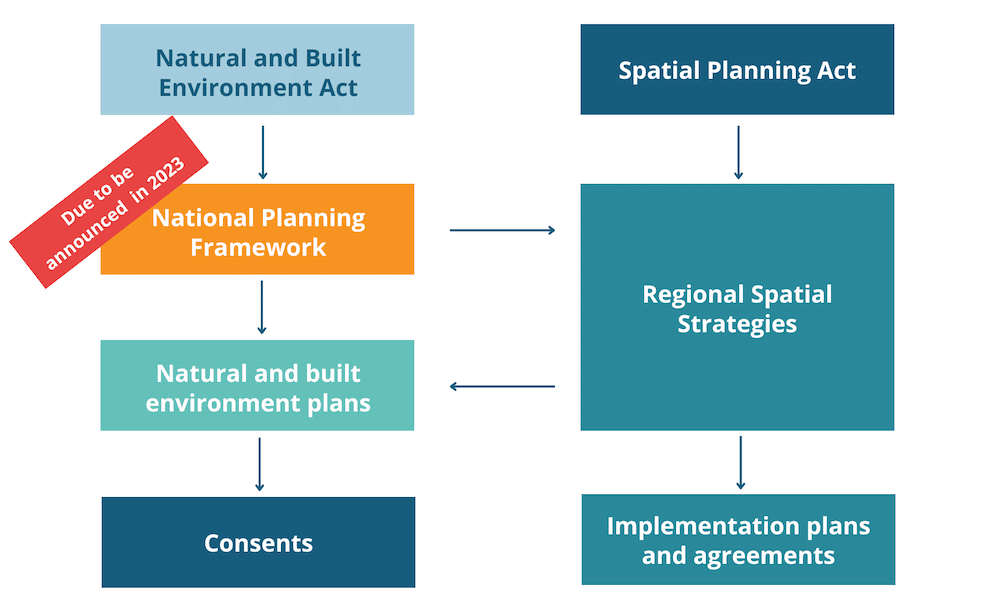If there is one thing property developers, farmers and environmentalists can agree on it’s that the current Resource Management System is broken. But will the proposed system announced today provide any relief to the present-day issues, and what will it mean for the property sector?
Property Council New Zealand’s Head of Advocacy, Katherine Wilson attended today’s announcement and gives you the run-down of what the two new pieces of legislation could mean for the property sector.
A shiny new system?
The Government and its officials have done a great job in trying to review a very complicated and problem ridden system – an almost impossible task to get everything right from day dot. It is important to view this commentary with that lens, knowing that improvements were always going to be needed to the draft legislation in order to achieve better outcomes for all. That being said, the Government’s willingness to listen and adapt will be tested in the coming months.
Today’s announcement saw more details around the future Natural and Built Environments Act (“NBA”) and Spatial Planning Act (“SPA”). In short, the NBA will be the closest replacement to the current Resource Management Act and will look at introducing the concept of te Oranga o te Taiao translated to mean the health and wellbeing of the environment. The SPA will focus on land use and environmental regulation.
In contrast, the SPA is the strategic framework for the development arm of the system which establishes Regional Spatial Strategies (“RSS”). RSS will develop 30-plus year plans seeking to streamline the planning process and provide more certainty for future development. However, representation of committees is given to central government, local government and iwi to decide whilst the question around funding and financing of infrastructure still remains unknown.
A single integrated system

Implementation plans and implementation agreements will sit under RSSs and will be high level plans for delivering priority actions in the RSS. Consultation with delivery partners such as central government, local government, iwi, Māori or the private sector will occur. Engagement with implementors is critical to ensure that plans can be implemented. However, arguably earlier engagement through the development of RSS will be more effective than at a later stage.
Another important area to mention is the National Planning Framework. The new system will have the National Planning Framework (NPF) sit below the NBA and alongside the SPA. In practice, the NPF will set the direction of national priorities (think urban development and highly productive soils) when developing plans.
As the draft legislation has been released well in advance of the National Planning Framework and the Climate Adaptation Act, we are concerned that today’s snapshot is only a glimpse of the overall system. Although we know that the National Policy Statement on Urban Development and the Medium Density Residential Standards will transfer to the National Planning Framework, it is unclear around the prioritisation of policy statements.
It is difficult to see the whole system without having all of the puzzle pieces.
How our future resource system will practically operate remains unseen until we have prioritisation of resources established through the National Planning Framework.
Natural and Built Environments Bill
The initial Exposure Draft of the Natural and Built Environments Bill omitted to incorporate the built environment within the purpose statement. However, today’s announcement saw the purpose incorporate the ‘use, development and protection of the environment.’
We are pleased to see that our previous concerns around this have been rectified. In our view, resource management reform should aim to simultaneously promote the wellness of both the built environment and the natural environment.
We wish to see outcomes that seek to achieve the development of communities with access to housing, education, health, and employment opportunities. In order to achieve this, we believe that the purpose section of the NBA should also incorporate the built environment.
Spatial Planning Bill
One Regional Spatial Strategy (RSS) will be developed for each region and comprise of governance groups made up of local government, central government and iwi. This places the onus on local government to decide who is represented. Exactly how many representatives, and whether the representatives are politicians or officials is entirely up to each local authority. This is classic public sector!
The Government’s decision to delegate the make-up and attendee numbers of RSS committees to local government is a disaster waiting to happen. Good governance has a clear purpose, structure and objectives with members bringing a wide range of thought, diversity, and skillsets to the table. There are no hard or fast rules around the governance structure – except that the make-up requires at least six members with at least two being appointed by Māori, and each local authority having to appoint at least one member. Central Government will also have a minimum of one delegate. No maximum representatives are established.
The representation of central government, local government and iwi, will continue today’s issues with the current system, namely, that the private sector is not consulted, consulted too late, and/or is not brought along for the journey.
We only have to look at the project example of Let’s Get Wellington Moving team where local governance has only gotten so far. Government investment in public transport will need certainty that the market will follow – and murky waters have held up the train/bus in this instance.
Early engagement with the private sector is critical to help shape the development of spatial plans. No one wants a train to nowhere.
Arguably, the Government has tried to achieve private sector involvement through the establishment of Implementation Plans and Agreements within the legislation. This would see delivery partners be consulted on Implementation Plans and Agreements. Although this is the next best thing after having a seat at the planning table, how much local government relies on and listens to the development sector will be critical to the success of regional planning. There is no point going down a rabbit hole of which location mass rapid transit stations are to occur without ensuring that the necessary houses and potential for offices and retail outcomes will follow.
Councils could create amazing regional plans, but without early private sector participation, outcomes of plans may never be achieved due to feasibility and practical restraints within the market.
Unfortunately, restricting RSS governance to the public sector will continue today’s tension within the planning system. The Government has a real opportunity to flip this on its head and invite the market around the decision-making table in order to seek a wide range of skill sets required. Increased collaboration and diversity of thought should be our superpower to create hugely positive outcomes for our current and future communities.
Funding and financing of infrastructure
What continues to remain unclear is how the funding and financing of core infrastructure will occur within the new resource reform system. Currently, we are facing the status quo on how we finance infrastructure which has resulted in New Zealand struggling to keep up with demand.
Property Council New Zealand is undertaking a separate workstream that relates to value capture around key transport nodes and encourages both central and local government to look at a much wider range of options to fund infrastructure.
It is important that future funding of infrastructure is clearly planned, communicated and delivered.
Resource consents
A key question for the property sector is whether the future system will seek to improve the current consenting process.
The NBA will standardise consent activity classes and notification rules which aim to provide more certainty and a reduction in resource consents required. In reality, this will see resource consent categories move from six categories to four (permitted, controlled, discretionary and prohibited).
Practically, the power still resides with local Councils and how they choose to apply the new resource consent process.
Council’s application will be critical to the workability of the newly categorised resource consents.
The Government conservatively estimates that the new system consent costs will fall by 19 per cent a year, or $149m. This is due to the proposed outcome of “more activities being permitted and fewer consents needed.” Additionally, fast-track consenting will continue for housing and infrastructure projects.
It is still unclear as to whether today’s announcements will make housing more affordable. Local Government is holding the keys here, and it will come down to Councils application of resource consents and planning.
Property Council will take a keen interest in our own members’ experience in relation to resource applications in order to report efficiencies and/or any anomalies and report these to the appropriate channels. It is imperative that costs and times involved in housing developments are reduced under the new system.
Transition period
The new system will be implemented in stages, with a full implementation expected to take 10 years.
How the new system transitions and central/local government learn from the process and adapt where necessary, will be critical to the success of the system.
With local government elections having only recently occurred, the first model councils are yet to be announced.
Summary
Today marks the start of a new resource management system for Aotearoa.
However, the Natural and Built Environments Bill and Spatial Planning Bill are two pieces of the puzzle. It will take many hands (and years) to legislate, plan, and implement the outcomes we want to achieve.
Early private sector involvement throughout legislative and planning processes could help us become one step closer to completing the puzzle – shaping cities where communities thrive.
Author | Katherine Wilson
As Property Council’s Head of Advocacy, Katherine is tasked with leading our advocacy campaigns at both a regional and national level.
Level-headed and engaging, Katherine has both a law degree from Otago University and an arts degree (majoring in politics) from Auckland University. With solid experience as a policy analyst and advisor in Wellington and Auckland, she has extensive networks and solid analytical skills.
Katherine is hugely dedicated, highly intelligent and committed to ensuring the voice of our members is heard at all levels of governance. She’s also relentlessly positive and enjoys a good chat.


